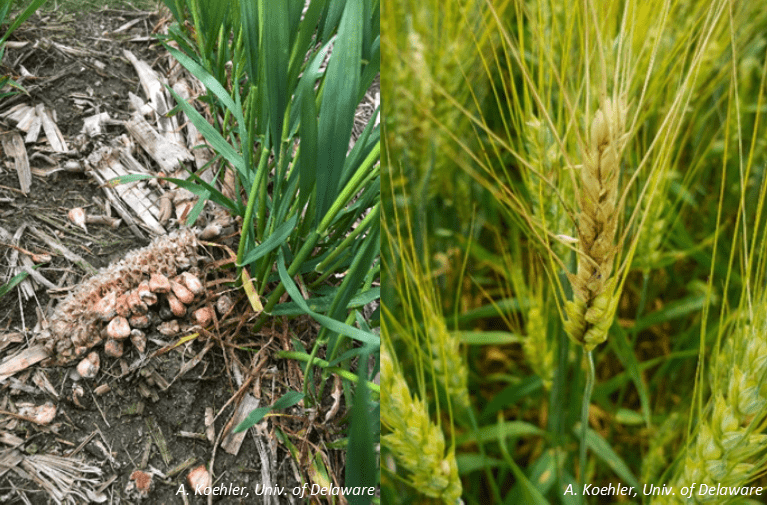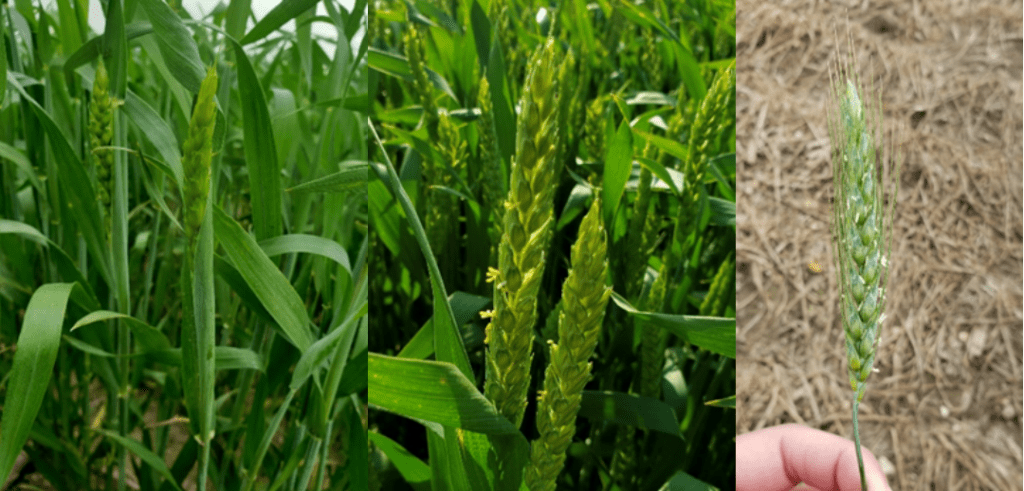Dr. Alyssa Koehler, Extension Field Crops Pathologist
University of Delaware
With the mild winter, wheat and barley are moving right along. Planting behind corn is common in our region, but this maintains inoculum for Fusarium Head Blight (FHB). Fusarium species that cause FHB can infect both corn and small grains. Walking through fields with corn stubble, you may see orange growth on old debris (Figure 1). Wet spring conditions favor fungal sporulation that can lead to infected wheat heads. As the pathogen grows on debris, spores are released that can be rain dispersed or moved through air currents. As the grain is flowering, spores land on the head or anthers, colonize these tissues, and move into the grain head. Once inside the grain, water and nutrient movement is disrupted, which results in the bleached florets we associate with FHB (Figure 2). Shriveled and wilted “tombstone” kernels can reduce yield and result in grain contaminated with mycotoxins. Deoxynivalenol (DON), also referred to as vomitoxin, is a health hazard to humans and animals. Wheat heads colonized later in development may not show dramatic symptoms, but can still have elevated DON.

As we approach heading and begin to think about in-season disease management strategies, a well-timed fungicide application can help to reduce disease severity and DON levels. It is important to remember that fungicides can help to reduce disease levels and DON (traditionally around 50% reduction on a susceptible variety), but they do not eliminate FHB or DON. To try to maximize the efficacy of fungicides, it is important to apply at the correct timing. Fungicides for FHB are most effective when applied during flowering in wheat and at head emergence in barley. The Fusarium Risk Assessment Tool (www.wheatscab.psu.edu) is a forecasting model that uses current and predicted weather forecasts to predict FHB risk. The model is currently being configured for this season and should be accessible at the link above by the end of the first week of April. Historically about 70% accurate, this tool aids in assessing FHB risk as wheat approaches flowering and fungicide application decisions are made. The pathogen that causes FHB infects through the flower and rainfall 7 to 10 days prior to flower favors spore production and increases risk of infection. Optimal wheat fungicide application is at early flowering (10.5.1) to about 5 days after. Although new products like Miravis Ace can be applied earlier, it is still best to wait for main tillers to be at 10.5.1 or a few days beyond so that secondary tillers have a greater chance of being at 10.3-10.5.1. If you spray too early, heads that have not emerged will not be protected by the fungicide application. When wheat heads begin to flower, look for yellow anthers in the middle of the wheat head. When at least 50% of main stems are flowering, you will want to initiate fungicide applications. As the flowering period continues, anthers will emerge from the top and then the bottom of the wheat heads. Anthers can stay attached after flowering but usually become a pale white (Figure 3, next page). Triazole (FRAC group 3) fungicides that are effective on FHB include Caramba (metconazole), Proline (prothioconazole), and Prosaro (prothioconazole + tebuconazole). Miravis Ace (propiconazole + pydiflumetofen) offers a triazole + SDHI, FRAC group 7. As a reminder, fungicides containing strobilurins (QoI’s, FRAC 11) should not be used past heading because these fungicides can result in elevated levels of DON. Flat fan nozzles pointed 90° down are great at covering foliage but they do not provide good coverage on heads, which is the target for FHB management. Nozzles that are angled forward 30-45° down from horizontal (30 degrees is better than 45) or dual nozzles angled both forward and backward give better contact with the head and increase fungicide efficacy. For ground sprays, fungicides should be applied in at least 10 gallons of water per acre.

Thinking beyond this season, an integrated approach can improve management of FHB and help to keep DON levels low. In your field rotation plan, avoiding planting small grains into corn residue will help to reduce the amount of initial inoculum in your field. If you have soybean fields that can be harvested early enough for a timely wheat planting, this rotation helps to break up Fusarium inoculum. In addition to rotation considerations, seed selection is another important piece of FHB management in wheat. There is no complete host resistance against FHB, but you can select wheat varieties with partial resistance. The University of Maryland sets up a misted nursery to compare FHB index and DON levels across local wheat varieties to aid in variety selection decisions. Results from 2019 can be found at https://scabusa.org/pdfs/UMD_Misted-Nursery_Factsheet-2019.pdf. Remember that these trials are conducted under extreme disease pressure and you want to look at relative DON performance. Unfortunately, barley does not have any resistance to FHB. In UMD’s 2019 trial, Calypso had the lowest DON content in local barley varieties tested.
